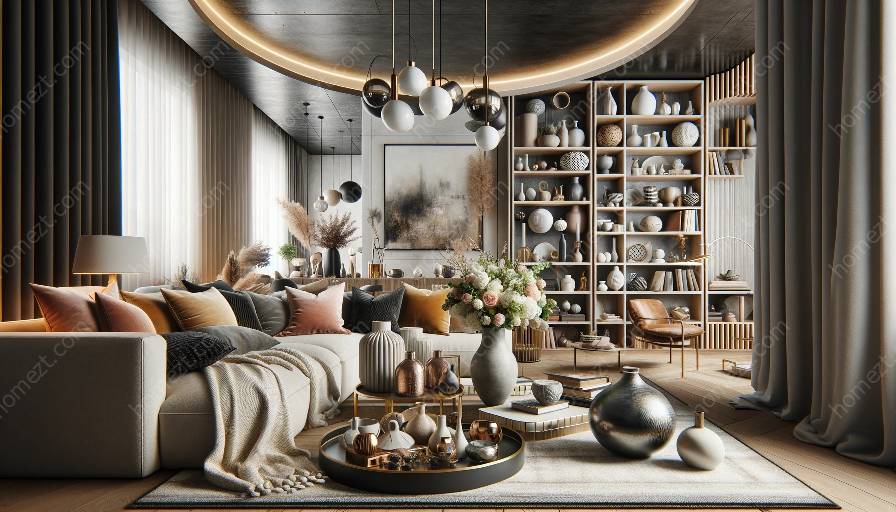An open-concept living space offers a spacious and versatile environment for decorating and accessorizing. When considering how to accessorize such a space, it's important to take into account various factors that contribute to the overall aesthetics and functionality. From the use of rugs and furniture placement to color schemes and lighting, every detail plays a vital role in creating a cohesive and attractive design.
Considerations for Accessorizing
Accessories are key elements that add personality, character, and functionality to an open-concept living space. Here are some essential considerations to keep in mind:
- Zoning Areas: In an open-concept space, it's crucial to define different areas for specific functions, such as dining, lounging, and working. Accessorizing can help delineate these zones, whether through the use of area rugs, lighting fixtures, or decorative screens.
- Furniture Scale: The scale of furniture and accessories should be proportionate to the space. Oversized pieces can overwhelm the room, while undersized ones might get lost in the openness. Finding the right balance is crucial for a harmonious look.
- Unifying Elements: Choose accessories that tie the entire space together. This can be achieved through cohesive color palettes, similar textures, and consistent design styles. By creating visual connections, the space will feel unified and well-composed.
- Functional Accessories: In addition to aesthetics, it's important to consider the practicality of accessories. For example, incorporating multipurpose storage solutions, such as ottomans with hidden compartments or stylish shelving units, can enhance both the look and functionality of the space.
- Personal Touch: Accessorizing is an opportunity to showcase personal style and interests. Incorporate meaningful decor items, such as artwork, family photos, and travel souvenirs, to infuse the space with personality and warmth.
Accessorizing Techniques
Once the considerations are taken into account, employing specific accessorizing techniques can further elevate the design of an open-concept living space:
- Layering: Layering accessories, such as throw pillows, blankets, and artwork, adds depth and visual interest to the space. Mix different textures and patterns to create a dynamic and inviting ambiance.
- Focal Points: Use accessories to draw attention to focal points, such as a statement wall, fireplace, or large windows. This can be achieved through strategically placed artwork, decorative mirrors, or eye-catching lighting fixtures.
- Balance and Symmetry: Achieving a sense of balance and symmetry through accessorizing can create a harmonious visual flow. Pairing matching accessories or arranging them in a symmetrical manner can contribute to a polished and well-organized look.
- Greenery and Natural Elements: Integrating plants, flowers, and natural materials, such as wood and stone, brings a sense of freshness and life to the space. Greenery can soften the lines of the open-concept layout and add a touch of natural charm.
- Statement Pieces: Incorporate one or two statement accessories, such as a bold area rug, a unique light fixture, or a standout piece of artwork, to infuse personality and drama into the space.
Integrated Decorating and Accessorizing
When it comes to decorating an open-concept living space, the integration of accessorizing techniques is key to achieving a cohesive and inviting atmosphere. Utilize the following decorating and accessorizing methods for a well-rounded design:
- Color Harmony: Choose a color scheme that flows seamlessly throughout the space. Whether through wall paint, furniture upholstery, or decor accents, a cohesive color palette enhances the visual continuity and unity of the open-concept area.
- Lighting Design: Proper lighting is integral to both decorating and accessorizing. Incorporate a combination of ambient, task, and accent lighting to illuminate different areas and highlight key accessories. From pendant lights to table lamps, the right lighting enhances the overall ambiance.
- Furniture Arrangement: Positioning furniture in a thoughtful and strategic manner is a fundamental aspect of decorating an open-concept space. Consider traffic flow, focal points, and conversation areas when arranging seating and other furnishings.
- Texture Variation: Introduce a variety of textures to create visual and tactile interest. From plush rugs and velvet upholstery to sleek metal accents, texture variation adds depth and dimension to the design.
- Artwork and Wall Decor: Incorporate artwork and wall decor as integral elements of the decorating and accessorizing process. Whether through gallery walls, statement pieces, or decorative mirrors, wall decor contributes to the visual appeal of the space.
Conclusion
Accessorizing open-concept living spaces involves thoughtful considerations and creative techniques that enhance the overall appeal and functionality of the area. By carefully zoning different spaces, unifying elements, and incorporating personal touches, you can create a well-balanced and inviting environment. Combining decorating and accessorizing methods, such as color harmony, lighting design, furniture arrangement, texture variation, and wall decor, results in a cohesive and visually compelling open-concept living space that reflects your personal style and enhances the overall atmosphere.






































